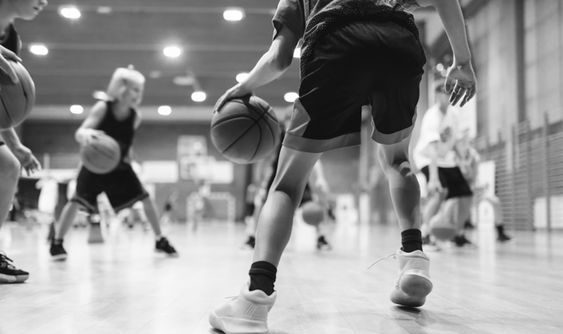How to Prevent Basketball Injuries
Basketball is an exhilarating sport that combines speed, agility, and teamwork. However, the physical demands of the game can lead to injuries if proper precautions aren’t taken. Whether you’re a seasoned player or just starting, understanding how to prevent basketball injuries is crucial for maintaining your health and performance on the court.
Understanding Basketball Injuries
Before diving into prevention strategies, let’s first understand the common types of basketball injuries.
Sprains and Strains
Sprains and strains are among the most frequent injuries in basketball. They occur when ligaments (sprains) or muscles (strains) are overstretched or torn, usually due to sudden movements or awkward landings.
Knee Injuries
Knee injuries, including ACL (anterior cruciate ligament) tears and meniscus injuries, can be particularly devastating. They often result from abrupt changes in direction, jumps, or collisions.
Ankle Injuries
Ankle sprains are common due to the frequent jumping and pivoting in basketball. These injuries can range from mild to severe and often result from landing awkwardly on another player’s foot or an uneven surface.
Finger and Wrist Injuries
Finger and wrist injuries, such as jammed fingers or wrist sprains, typically occur from contact with the ball or other players. These injuries can impact a player’s ability to handle and shoot the ball effectively.
Head Injuries and Concussions
Although less common, head injuries and concussions can occur from falls or collisions. These injuries require immediate attention and proper management to prevent long-term effects. Also, read about Improve Basketball Shooting Accuracy
Warm-Up and Stretching
A proper warm-up and stretching routine is essential for preparing your body for the physical demands of basketball.
Importance of a Proper Warm-Up
Warming up increases blood flow to muscles, enhances flexibility, and reduces the risk of injury. A good warm-up should include light aerobic exercises like jogging or jumping jacks to get your heart rate up.
Effective Stretching Techniques
Incorporating both dynamic and static stretching into your routine can improve flexibility and range of motion.
Dynamic vs. Static Stretching
- Dynamic Stretching: These are active movements that stretch the muscles and prepare them for activity. Examples include leg swings and arm circles.
- Static Stretching: These involve holding a stretch for a period, usually after playing, to help cool down muscles and maintain flexibility.
Strength and Conditioning
Building overall strength and conditioning can significantly reduce the risk of injuries.
Building Core Strength
A strong core improves balance and stability, which are vital for performing basketball movements safely. Exercises like planks and Russian twists are excellent for core strength.
Lower Body Strengthening
Strengthening the muscles in your legs, such as the quadriceps, hamstrings, and calves, can help protect your knees and ankles. Squats, lunges, and calf raises are effective exercises for lower body strength.
Upper Body Conditioning
Upper body strength is important for shooting, passing, and rebounding. Incorporate exercises like push-ups, pull-ups, and dumbbell presses to build upper body strength.
Importance of Flexibility
Maintaining flexibility through regular stretching can prevent muscle tightness and improve overall performance. Yoga and Pilates are great for enhancing flexibility. DIscover more about basketbalteam.com
Proper Technique and Form
Using the correct technique and form in basketball can prevent injuries and improve your game.
Shooting Form
Proper shooting form not only enhances accuracy but also reduces strain on your arms and shoulders. Focus on keeping your elbow in and following through with your wrist.
Defensive Stance
A good defensive stance involves keeping your knees bent, back straight, and weight on the balls of your feet. This position allows for quick movements and reduces the risk of knee and ankle injuries.
Jumping and Landing Mechanics
Proper jumping and landing techniques are crucial for preventing injuries. When jumping, use your legs to generate power and keep your knees bent upon landing to absorb the impact.

Equipment and Gear
Using the right equipment and gear can provide additional protection against injuries.
Proper Footwear
Wearing basketball-specific shoes with good ankle support and cushioning can prevent many foot and ankle injuries. Make sure your shoes fit well and are in good condition.
Protective Gear
Consider wearing protective gear such as knee pads, ankle braces, and mouthguards to reduce the risk of injury.
Maintaining Equipment
Regularly check and maintain your equipment to ensure it remains in good condition. Replace worn-out shoes and gear to avoid potential hazards.
Hydration and Nutrition
Proper hydration and nutrition are key components of injury prevention.
Importance of Staying Hydrated
Dehydration can lead to muscle cramps and fatigue, increasing the risk of injury. Drink plenty of water before, during, and after games and practices.
Nutritional Tips for Basketball Players
A balanced diet rich in carbohydrates, proteins, and healthy fats can fuel your body for optimal performance and recovery.
Pre-Game and Post-Game Nutrition
- Pre-Game: Eat a meal rich in complex carbohydrates and lean proteins a few hours before playing. Consider a light snack like a banana or a granola bar 30 minutes before the game.
- Post-Game: Replenish your energy stores with a mix of proteins and carbohydrates. A smoothie with protein powder, fruits, and vegetables is a great option.
Recovery and Rest
Giving your body time to recover is essential for preventing overuse injuries.
Importance of Rest Days
Incorporate rest days into your training schedule to allow your muscles to repair and grow. Overtraining can lead to fatigue and increase the risk of injuries.
Effective Recovery Techniques
Use techniques such as foam rolling, massage, and stretching to aid in muscle recovery. Ice baths can also help reduce inflammation after intense workouts.
Listening to Your Body
Pay attention to any signs of pain or discomfort. If something doesn’t feel right, take a break and seek medical advice if necessary.
Mental Preparation
Mental preparation is just as important as physical preparation in preventing injuries.
Importance of Mental Toughness
Building mental toughness can help you stay focused and resilient, reducing the likelihood of making mistakes that lead to injuries.
Visualization Techniques
Use visualization techniques to mentally rehearse movements and plays. This can improve your performance and confidence on the court.
Stress Management
Manage stress through relaxation techniques like deep breathing, meditation, and mindfulness. A calm mind can better handle the pressures of the game.
Training and Drills
Incorporating specific training and drills can enhance your skills and reduce injury risk.
Importance of Skill Drills
Regularly practicing skill drills can improve your technique and overall performance, making you less prone to injuries.
Conditioning Drills
Conditioning drills like sprints and agility exercises can improve your endurance and reduce the risk of fatigue-related injuries.
Injury Prevention Drills
Include drills that focus on strengthening the muscles and joints most vulnerable to injury. Balance exercises and plyometrics can enhance stability and coordination.
Professional Guidance
Seeking professional guidance can provide personalized advice and training to prevent injuries.
Working with Coaches
Coaches can help you develop proper techniques and strategies tailored to your needs, reducing the risk of injury.
Consulting Physical Therapists
Physical therapists can design injury prevention programs and provide treatment if you get injured.
Importance of Regular Check-Ups
Regular check-ups with healthcare professionals can help detect and address any potential issues before they become serious injuries.

Common Mistakes to Avoid
Avoiding common mistakes can significantly reduce your risk of injuries.
Overtraining
Pushing your body too hard without adequate rest can lead to overuse injuries. Balance intense workouts with proper recovery.
Ignoring Pain
Never ignore pain or discomfort. Pain is your body’s way of signaling that something is wrong. Address any issues promptly to prevent further injury.
Neglecting Warm-Up and Cool Down
Skipping warm-up and cool-down routines can increase the risk of injury. Always take the time to prepare your body before and after playing.
Dealing with Injuries
Knowing how to deal with injuries effectively can speed up recovery and prevent future issues.
Immediate Steps After Injury
If you get injured, stop playing immediately and apply the R.I.C.E. method: Rest, Ice, Compression, and Elevation. Seek medical attention if necessary.
Rehabilitation Process
Follow a structured rehabilitation program to ensure a full recovery. This may include physical therapy, exercises, and gradual return to activity.
Returning to Play Safely
Only return to play when you are fully recovered and have received clearance from a healthcare professional. Rushing back too soon can lead to re-injury.
Parental and Coach Involvement
Parents and coaches play a crucial role in preventing injuries.
Role of Parents in Injury Prevention
Parents should ensure their children have the proper gear, maintain a balanced diet, and get adequate rest. Encouragement and support are also vital.
Coaches’ Responsibilities
Coaches should create a safe training environment, teach proper techniques, and monitor players for signs of fatigue or injury.
Creating a Safe Training Environment
Ensure the training area is free of hazards, and equipment is well-maintained. Emphasize the importance of safety during practices and games.
Conclusion
Preventing basketball injuries involves a multifaceted approach that includes proper training, equipment, nutrition, and mental preparation. By understanding common injuries and implementing these prevention strategies, players can enjoy the game safely and perform at their best. Remember, staying proactive and attentive to your body’s needs is key to a long and healthy basketball career.
FAQs
What are the most common basketball injuries?
The most common basketball injuries include sprains and strains, knee injuries, ankle sprains, finger and wrist injuries, and concussions.
How can I prevent ankle sprains while playing basketball?
You can prevent ankle sprains by wearing proper footwear, strengthening your ankle muscles, and practicing good jumping and landing techniques.
What should I eat before a basketball game?
Before a game, eat a meal rich in complex carbohydrates and lean proteins a few hours prior, and have a light snack like a banana or granola bar about 30 minutes before playing.
How important is strength training for basketball players?
Strength training is crucial for basketball players as it helps build muscle, improve endurance, and prevent injuries by enhancing stability and support for joints.
What should I do if I get injured during a game?
If you get injured during a game, stop playing immediately, apply the R.I.C.E. method (Rest, Ice, Compression, Elevation), and seek medical attention if necessary.
Alina is a passionate basketball player with a love for the game that knows no bounds. With years of experience on the court, she brings unmatched skill and dedication to her team. Alina’s commitment to excellence both on and off the court sets her apart as a leader and motivator. Whether she’s driving to the basket or encouraging her teammates, Alina’s enthusiasm and sportsmanship shine through. As a valuable member of the basketball team, Alina’s presence elevates the spirit and performance of the entire squad.







